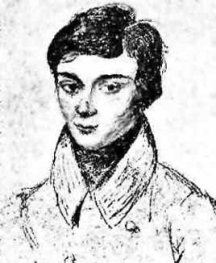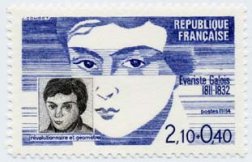The tragic tale of Évariste Galois (1811–1832), a mathematical prodigy who died in a duel at the tender age of 20, is one of the more dramatic stories in the history of mathematics.


Most people owe what they know about Galois to a stirring account written in 1937 by mathematician Eric Temple Bell in his book Men of Mathematics. In a chapter titled “Genius and Stupidity,” he described the young Galois and his tormented state of mind on the night before the ill-fated duel.
Bell wrote: “All night . . . he had spent the fleeting hours feverishly dashing off his last will and testament, writing against time to glean a few of the great things in his teeming mind before the death which he foresaw could overtake him. Time after time he broke off to scribble in the margin ‘I have not time; I have not time,’ and passed on to the next frantically scrawled outline. What he wrote in those desperate last hours before the dawn will keep generations of mathematicians busy for hundreds of years.”
Great stuff–the sort of tragic but inspiring tale that readily gets passed on from one generation of math students to another. Indeed, Bell’s account is echoed in numerous textbooks, articles, and other material.
The facts, however, do not support the picture that Bell painted of a misunderstood boy genius, hindered and persecuted by those around him too stupid to understand his mathematical achievements and appreciate his talent.
In a chapter of his 1991 book Science à la Mode, cosmologist Tony Rothman tried to set the record straight. He demonstrated where Bell went astray.
Rothman pointed out that Galois’ own arrogance, erratic temperament, and self-destructive tendencies contributed greatly to his difficulties in getting his mathematical ideas accepted, to his failure to pass the exam necessary to get into the prestigious École Polytechnique, and to his political misfortunes and eventual downfall.
In the Norton History of the Mathematical Sciences, Ivor Grattan-Guinness declares that “Galois was known around town as a loud-mouthed and opinionated republican, not a good reputation to have either before or after the 1830 revolution.”
As for Galois’s final night, Rothman debunks the romantic notion of a doomed genius working feverishly by candlelight to commit his revolutionary theory of equations and groups to paper. In fact, Galois had been writing papers on the subject since the age of 17, and the new idea of “group” that he had introduced is found in all of them. Nonetheless, Galois did help create a field that would keep mathematicians busy for hundreds of years, but not in one night!
What about the famous inscription “I have not the time”? It appears only once in a final letter to a friend, scrawled next to a particular theorem after he had written the words, “There are a few things left to be completed in this proof.”
Historians have long argued about who shot Galois and what the duel was about. Some have proposed that Galois was set up by the police to silence him for his radical views. More recently, Laura Toti Rigatelli has proposed that there was no duel at all. Instead, a despondent Galois may have offered up his life as a martyr to further the republican cause.
In his essay, Rothman identified serious difficulties with the political enemies scenario. Instead, he posited that there truly was a duel, fought over a woman—17-year-old Stéphanie-Felicie Poterin du Motel. According to Rothman, Galois’ opponent was Ernest Armand Duchâtelet, a student and friend of Galois. In Rothman’s view, the evidence points to two friends falling in love with the same woman and settling the issue in a game of Russian roulette.
In The Equation That Couldn’t be Solved, Mario Livio agrees that the fight was over Stéphanie, but he adds an additional wrinkle to the tale. Based on his investigations, Livio contends that Galois faced two adversaries: Duchâtelet and Denis Faultrier, a former captain in the national guard and owner of the sanatorium where Galois was boarding. Galois had, in some way, offended the girl, and Duchâtelet, her lover, and Faultrier, who later married the girl’s widowed mother, defended Stéphanie’s honor.
“On the morning of May 30, 1832, Galois and Duchâtelet faced each other at twenty-five paces, with Faultrier waiting for his turn,” Livio writes. “By a Russian-roulette-style procedure, Duchâtelet happened to pick the loaded gun and shot Galois.”
According to Livio, the autopsy report indicates that, although Galois was hit in the stomach, he did not stand fully sideways, in a way that would have minimized his chances of being hit. “Did he not care to live?” Livio asks. “Given his state of mind this is not impossible.”
In his 1998 novel The French Mathematician, Tom Petsinis, a novelist, poet, playwright, and math instructor in Melbourne, Australia, presented the tragic tale as if it were told by Galois himself. In his account, Petsinis stuck as closely as he could to the known facts of Galois’ life.
However, Petsinis followed the lead of 19th-century French novelist Alexandre Dumas in naming Pescheux d’Herbinville as Galois’ adversary. Like Galois, d’Herbinville was a republican, and the young man was supposedly in love with Stéphanie. However, the evidence now appears to absolve d’Herbinville of the crime.
As for Petsinis’ account of Galois’ life, I’m not convinced that he truly captured Galois’ evolving state of mind. Many times, Galois’ mathematical thoughts seemed too modern—too informed by recent developments in mathematics to be genuinely his. Similarly, I found his depiction of the psychological transformations that distracted Galois away from his mathematical studies into politics sometimes less than compelling.
Petsinis did, however, bring to vivid life the passions, complexities, and uncertainties of life in Paris during the tumultuous years of conflict between royalists and republicans after the exile of Napoleon Bonaparte.
In the meantime, Galois’ story remains as dramatic and engrossing as ever.
Originally posted: Feb. 27, 1999
Updated: Feb. 25, 2006
Check out Ivars Peterson’s MathTrek blog at http://blog.sciencenews.org/.






